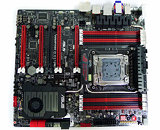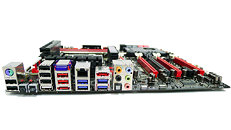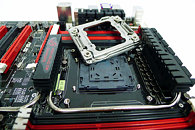Tuesday, October 25th 2011

ASUS Rampage IV Extreme Cometh
Here is ASUS' top of the line LGA2011 motherboard targeting the gamer-overclocker market, the Republic of Gamers (ROG) Rampage IV Extreme. This board offers all the expansion room and connectivity you'll ever need, plus a wealth of nifty features that help overclockers and ease incremental upgrades. To begin with, the Rampage IV Extreme employs a strong digital PWM circuitry that supports heavy voltage-assisted overclocking with Vdroop control.
The LGA2011 socket is wired to eight DDR3 DIMM slots (two per channel). CPU and memory VRM areas are located along three sides of the socket, all cooled by heatsinks that are connected by heat pipes. These VRM heatsinks share heat with the one over the X79 PCH, which is actively cooled by a fan.Expansion slots include four PCI-Express 3.0 x16 (red), of which two are x16-capable, and all are x8 capable, one PCI-Express 2.0 x4 (black, wired to the PCH), and an x1 slot. Storage connectivity includes four each of SATA 6 Gb/s (red) and SATA 3 Gb/s (black), and one eSATA, and a power-eSATA (unknown datarate). There are eight USB 3.0 ports (four each on the rear panel and front-panel headers). Surprisingly, there's only one gigabit Ethernet connection, the other connectivity option is Bluetooth, which plays a key role in some of the ROG-exclusive features such as ROG Connect. For once, ASUS did away with the Creative X-Fi soft-layer for its audio and the solution is pure Realtek ALC898 8+2 channel HDA codec (with Realtek driver).
Where do I even start with the toys overclockers get with this board? OK, first, the LGA2011 socket is designed in such a way that its Intel-spec retention bracket can be replaced by a custom ASUS-designed one, that modifies the cooler mount holes to make the socket compatible with LGA1366-ready coolers, so you can carry on with your expensive LGA1366-ready water-block. Second, there is a strong VRM that's backed by diagnostic phase and temperature LEDs, voltage direct-measurement points, and a EPU chip that marshals the power phases. There is redundant BIOS (in separate socketed serial EEPROM chips), with ASUS ROG-exclusive UEFI firmware. Thirdly, power is drawn, apart from the 24-pin ATX and 8-pin EPS, by a 4-pin ATX (CPU power) and a 6-pin PCIe, so electrical stability is maintained. The ROG connect feature lets you monitor and overclock your board from Bluetooth-enabled smartphones (hence the Bluetooth controller).
To top it off, every Rampage IV Extreme packs a free copy of Battlefield 3 Special Edition (bundles Physical Warfare and/or Return to Karkhand DLC(s)).
Source:
VR-Zone
The LGA2011 socket is wired to eight DDR3 DIMM slots (two per channel). CPU and memory VRM areas are located along three sides of the socket, all cooled by heatsinks that are connected by heat pipes. These VRM heatsinks share heat with the one over the X79 PCH, which is actively cooled by a fan.Expansion slots include four PCI-Express 3.0 x16 (red), of which two are x16-capable, and all are x8 capable, one PCI-Express 2.0 x4 (black, wired to the PCH), and an x1 slot. Storage connectivity includes four each of SATA 6 Gb/s (red) and SATA 3 Gb/s (black), and one eSATA, and a power-eSATA (unknown datarate). There are eight USB 3.0 ports (four each on the rear panel and front-panel headers). Surprisingly, there's only one gigabit Ethernet connection, the other connectivity option is Bluetooth, which plays a key role in some of the ROG-exclusive features such as ROG Connect. For once, ASUS did away with the Creative X-Fi soft-layer for its audio and the solution is pure Realtek ALC898 8+2 channel HDA codec (with Realtek driver).
Where do I even start with the toys overclockers get with this board? OK, first, the LGA2011 socket is designed in such a way that its Intel-spec retention bracket can be replaced by a custom ASUS-designed one, that modifies the cooler mount holes to make the socket compatible with LGA1366-ready coolers, so you can carry on with your expensive LGA1366-ready water-block. Second, there is a strong VRM that's backed by diagnostic phase and temperature LEDs, voltage direct-measurement points, and a EPU chip that marshals the power phases. There is redundant BIOS (in separate socketed serial EEPROM chips), with ASUS ROG-exclusive UEFI firmware. Thirdly, power is drawn, apart from the 24-pin ATX and 8-pin EPS, by a 4-pin ATX (CPU power) and a 6-pin PCIe, so electrical stability is maintained. The ROG connect feature lets you monitor and overclock your board from Bluetooth-enabled smartphones (hence the Bluetooth controller).
To top it off, every Rampage IV Extreme packs a free copy of Battlefield 3 Special Edition (bundles Physical Warfare and/or Return to Karkhand DLC(s)).




55 Comments on ASUS Rampage IV Extreme Cometh
:twitch:why intel....... why.......
SO MANY CHOICES....:banghead:.... 2011..... IVY BRIDGE.....SO MUCH AWESOME:rockout:
GOTTA GETEM ALL GOTTA GETEM ALLL!!!!!!!!
oh yeah ...this is about the board....yeah its awesome!
Edit: Actually, looking back at the recently released photos of X79 boards, a few of them do have an extra x8 slot coming from the CPU. The ones in the beginning I believe did not.
Its not true. Intel does it ALL the time to their buyers. Introduce a mega costly kick ass system and come within 95% on a stock budget system 3 months later.
Ivy bridge WILL kick 2011's ass in all thing s not capable of handling a $1000-1500 8 core -16 threaded beast.
IE most applications.
Hell even handbrake maxes at 8 threads. disable HTT on 2011 and YES it will beat a sandy B i7.
Only cuz its 8 real cores. But at 3 times the cost it will not have 3 times the performance only the same perf clock for clock core for core.
2011 quads, will be in the 250-400 range I bet and be no differnet than 1155 i7s
EDIT: Im cheap i like mich ultras.
BTW I have seen the sneak peaks of x79 about a month ago ;)
Its cool man I will give you a 6 of draughts and tell you what, its same price anyway, you get me a 4 pack of Guiness stouts in a can. If I am right :) core for core clock for clock.
And if future revisions are indeed pcie 3.0, than 80% less latency as well. 2b encoding on PCIE 3.0. w00t!
The GbE controller in this board is Intel-made, and uses the chipset's GbE lane. Intel chipset GbE lane is a specialised PCI-E 1.1 x1 link which is clocked at 50 MHz. Intel High Definition Audio bus is physically a PCI-Express 1.0 x1 link. Both GbE and HDA don't eat into the 12 lanes.
Not trying to be a pain in the ass, just want to know how you're getting your info.